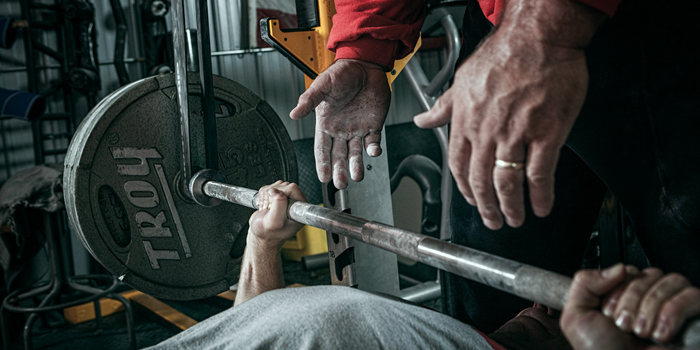
Prilepin’s Chart supplies coaches with a cogent synthesis of training variables into four brackets: narrowed percentage spectrums, their attendant volume strictures, optimal total repetitions, and repetition ranges. Nevertheless, it simultaneously reveals an unfathomable amount of progressions. One of the best things to do when challenged by overwhelming options is to elect the most basic approach. It is this article’s intention to impart an easily identifiable progression in accordance with Prilepin’s stipulations and practical examples of it, which I’ve used at the Division I level.
At a glance, one may recognize that the chart begins with the lowest allotted intensity and highest prescribed volume and continues down an additional three tiers, each descending in volume while increasing in intensity. Therefore, the simplest means of formulating a concise progression based on Prilepin’s Chart is to predicate the synthesis of it on linear periodization specifications, as it is already presented in such a fashion.
RECENT: Mental May — Destroying Demons
With regard to Prilepin, engendering a succinct, easily discernable pattern of overload requires one to begin with the highest set count, repetitions, and intensity, and reduce each variable for each succeeding tier. Fifty to sixty-five percent constitutes the allotted intensities in the first block with total repetitions set at 24 and an optimal repetition range of 18-30. Being that the percentages are fairly low, I assigned the highest total repetition count for this block at five sets of six, and designated 65 percent as the corresponding percentage, the highest allotted.
Prilepin set and repetition parameters appear exceedingly minimal to many, and understandably so. In order to progress linear training in accordance with these sometimes frustrating confines, it behooves one to appoint the highest possible volume in the first block, as that furthers room for reasonable volume adjustment in the following tiers, specifically volume reduction. 5x6 at 65 percent enables overload to continue at a reasonable pace, descending to 4x5 in Block 2, 3x4 in Block 3, and 2x3 in Block 4.
All assigned sets and repetitions should hover as close as possible to the recommended total amount of repetitions, with 4x5 in Block 2 set at two repetitions higher than the 18 recommended; Block 3’s 3x4 set at three repetitions below the advised 15; and Block 4’s 2x3 at two repetitions higher than the four proposed.
A noticeable element of many examples contained herein is the two weeks spent at each repetition range. Performing four sets of five repetitions for Weeks 2 and 3 allows for a gradual increase in intensity from 72.5 to 77.5 percent, which is a principle emphasized in Weeks 5 and 6 as well.
The table ends with 2x3 at 90 percent, as I believe that intensity for two working sets is sufficient for peaking the athlete a week prior to testing.
The week succeeding Block 4’s quantitative parameters should comprise a 1RM test — if their training age, technique, and physical development grant you the confidence to expose them to such — or an open-cut test explained in greater detail later in this article.
The following tables appear in order of Prilepin’s Chart and my interpretation of it, with the recommendations of this interpretation being utilized in ways dissected in greater detail throughout the article.
Prilepin's Chart
Personal Interpretation
The tables presented below adhere to the 13-week timeline we have with spring Olympic sports at the collegiate level, with the shortest exception spanning two months to cater to program disruption — divergence from a scheduled program occurs quite often, due to canceled lifts, inclement weather, and the all-too-common high volume sports practice.
Football follows a distinct schedule, and the tables contained herein may not be applicable to collegiate-level football; however, all tables are applicable to off-season summer programs, football included, due to the considerations taken into account by the acclimation microcycles in reference to the time contact sports need to recover from the rigors of their respective sports, with Option 4 serving as a preeminent mesocycle for said purpose.
Option 1: Good for freshmen and underachievers who come back from a summer of inactivity
The unfortunate reality of collegiate strength and conditioning is the epidemic of athletes’ inactivity over the course of the summer months. Inactivity to that degree demands that coaches acquiesce to regressions in both qualitative and qualitative programming aspects, as a preemptive tactic to avoid injury. We are the front line in injury prevention. An element of said responsibility is to augment strength, with strength training serving as the unassailable, preeminent means of burgeoning musculoskeletal resiliency.
Therefore, the first microcycle attends to both of the aforementioned concerns by progressing intensity and volume in a linear fashion. Linear periodization adheres to strict blocks dedicated to particular ends.
The first block is typically devoted to hypertrophy and endurance, with the succeeding three blocks concentrating on basic strength, strength, power, and finally, peaking, respectively.
Typical quantitative reflections of these aims appear as follows:
Common Linear Periodization Structure
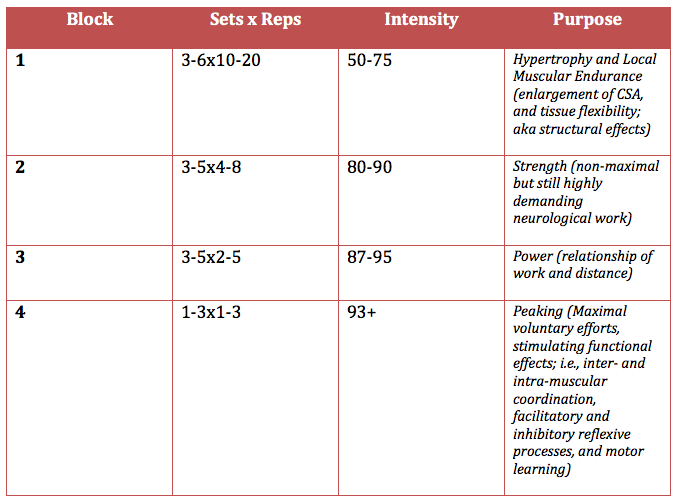
The first four weeks of the first microcycle in the table below are synthesized versions, in accordance with Prilepin, of the above four blocks that would otherwise last up to roughly four weeks each. Due to athletes’ low training age and a sizeable predilection on the behalf of some for a sedentary lifestyle during the off-season, testing conventions must reflect these considerations.
Week 5 is an open-cut set of eight to ten repetitions. While testing, focus on their form and speed of movement on each repetition, either allowing them to continue the set at eight, nine, or ten repetitions, otherwise referred to as “open” or “close,” establishing an 8RM, 9RM, or 10RM, and allowing an approximation of their 1RM without exposure to maximal weights for which they lack the technical and psychological criteria to execute soundly. The sets and reps designated to each week, along with corresponding percentages, should be elected with care.
Week 1 takes the highest allotted amount of repetitions within the 50 to 65 percent tier of Prilepin’s Chart. The purpose of the above is to maximize the amount of mechanical work performed, in order to further induce impact on muscle metabolism and hypertrophy. The highest percentage was selected to maximize the intensity of the drill within the provided constraints.
This first week should focus not just on appropriate mechanics but also the speed of the concentric action. Intent during movement is not easily imparted but extremely vital for force development.
According to the interpretation of Prilepin provided in Option 1, four sets of five reps is the succeeding quantitative progression, with total volume only two repetitions above Prilepin’s optimal total rep count. Seventy-five percent was chosen as the intensity, as it is the median percentage between the acceptable 70 to 80 percent purveyed for this block.
It is ideal to delegate each week to the next logical step in both intensity and volume in accordance with Prilepin, so both the magnitude of the load and volume progress at an acceptable rate; both of which expose the athlete to acceptable loads above habitual levels to induce adaptation while being sure to not overload them to degrees they can’t execute with proper technique and force-velocity characteristics.
Week 3 follows the same approach as Week 2, selecting the median percentage between given percentages of 80 to 90 and a volume prescription of 3x4 to hover near the optimal repetition count of 15.
Week 4, descending in both reps and sets, places the load at 90 percent, the minimum of this portion of Prilepin’s Chart, and exposes the athlete to a heavier load still lower than the maximum percentage associated with three repetitions at 93 percent. The antecedent furthers time between the advent of the program, and the submaximal effort’s more demanding counterpart, the repeated method, which will be administered during Week 5.
Weeks 5, 10, and 13 all follow repeated effort parameters with each testing week, reflecting a higher percentage that corresponds to each increasingly intense microcycle. Notice that each succeeding microcycle begins and ends at a higher intensity than its predecessor, with repetitions decreasing over the duration of that cycle in an easily distinguishable style of linear periodization.
The open-cut testing sets are all performed with the percentage of a 1RM associated with the minimum amount of repetitions allotted. In this example, Week 10 is done at 87 percent with five repetitions as the minimum. Again, striving for repetition-based personal records is effective not only for their ability to ascertain one’s 1RM — the accuracy of approximation is ever more precise with lower repetitions — but also due to its association with submaximal loads shy of 100 percent. Regarding loads equivalent to or higher than 100 percent, athletes will have reinforced technique and musculature by Week 13, at which they may test a 1RM.
The third microcycle contains the most accurate estimation of what that 1RM may be and enables the coach to increase the load to over 100 percent, depending on strength levels, reinforced relevant musculature, and technical competency.
You may use this week to test their established 1RM to ensure that your estimations have been calculated accurately, and expose the athletes to maximal load. You may also utilize Week 13 to increase their 1RM yet again by executing weights at 100 percent or more.
Option 2: Repetition Effort Mesocycle (Good for returners, overachievers, and those with high training age)
This version of periodization may diverge from the traditional Prilepin set and repetition guidelines, yet its ability to yield results is advantageous to the collegiate athlete who is well-versed in pertinent movement patterns and has spent time fortifying apt muscle groups.
One set to failure, otherwise known as a repetition maximum set or 1RM, mitigates the amount of mechanical work an athlete will be executing, lending itself as a form of periodization that attenuates soreness with no adverse effects on practice and competition performance. It is, more than anything, weekly undulation.
We typically observe undulation occurring on a daily basis; however, implementations of it on a weekly basis do exist, with significant results. In short, the administration of the succeeding involves calculated alterations of quantitative facets of programming.
RMs are the manifestation of the repeated effort method. Many are familiar with its submaximal counterpart, as it is widely utilized with accessory movements. The defining difference between repeated and submaximal methods is that the repeated effort behests the athlete to perform a non-maximal load to complete failure, inciting an inimitable amount of motor units to be recruited and the greatest force to be produced while fatigued. Additionally, the submaximal effort method does not improve neuromuscular coordination to the degree that repeated effort does. Repeated effort instigates accruals in intramuscular and intermuscular coordination that are requisites for augmenting maximal strength.
Consequently, the athlete isn’t exposed to maximal percentages until the eighth week of training, allotting them sizeable time to establish and reinforce movement pattern, and relevant musculature, while sparing them the high emotional and Central Nervous System stress concomitant with the maximal effort method. The antecedent isn’t a condemnation of the submaximal and maximal methods, but rather, an explication of the benefits of the repeated method.
Nevertheless, it’s significant to concede that endeavoring to execute RMs, especially at a percentage higher than that of its typical corresponding percentage, is emotionally taxing in its own right. Although it is distinct, similarities between repeated effort and to the maximal effort methods do exist. Criteria for RM training comprises elevated focus, intent, substantial reliance on emotional reserves, and physical exertion far beyond submaximal effort.
Bearing the aforementioned in mind, it’s practical to administer the succeeding form of periodization in the off-season months of summer with football players who typically have higher training ages than Olympic sports or any Olympic athletes with sizeable training age. It’s also a great tool for those who don’t receive any playing time, as it purveys them with a renewed sense of purpose with the additional benefit of conceivably drawing the attention of coaches due to heightened levels of strength. Lifting often becomes the obsession of a collegiate athlete, especially if they’ve benched, as it’s a potent tool for buoying their spirits in an otherwise ultra-competitive atmosphere that can spur negative self-image and attitude.
RELATED: So You Want to Be A Collegiate Strength Coach: The Pros
Training with RMs works exceedingly well with undulation. Although undulation is typically thought of as a daily form of periodization selected when performance of the same movement pattern exceeds once per week, weekly undulation, anecdotally speaking, has produced substantial results.
Select an RM — in this case, a 10RM in Week 1 — and implement it with the percentage ubiquitously associated with it (75 percent). Continue by executing another 10RM two weeks later at the next highest percentage of 77 percent, affiliated with a 9RM. In effect, what was once your 10RM is now your 9RM, increasing your estimated 1RM.
Field experience has shown that lower training ages respond better to two weeks between RM attempts of the same repetition total. Those with higher training ages may elect to perform the same RM count the following week (i.e., 10RM during Weeks 1 and 2). Utilize the week that lies between mirroring RM totals as an opportunity to expose the athlete to higher percentages (this principle is reflected in Weeks 2, 4, 6, and 8), and ascertain any technical faults that may present themselves in the face of heightened intensities.
In doing so, you may prevent technical breakdowns in heavier subsequent weeks, thereby improving strength and mitigating onset of injury. The aforementioned is vital as 1RM approximation accuracy improves with lower RMs. Although Week 3 may produce an increased maximum, the most accurate 1RM estimation should rely far more heavily on Week 4’s performance. If the first four weeks go according to plan, then the athlete will have performed a 5RM percentage for six repetitions, increasing their estimated 1RM to 511.7 pounds.
The weights for Weeks 5 through 8 are generated by a 512-pound maximum (rounded up from 511.7 pounds). Successful completion of Week 8’s weight will lead to an accurate approximation of a 527.7-pound maximum, prior to a true 1RM attempt on the ninth and final week of the program.
Calculation of a new maximum is achieved by dividing the new RM weight by the previous percentage utilized with the same RM. For example, if the athlete squats 475 pounds on Week 8 for four repetitions, what was once their 3RM (93 percent of their 1RM) is now their 4RM (90 percent of their 1RM). It is only by dividing 475 by 0.9 — the percentage ubiquitously associated with a 4RM — that we ascertain the athlete’s new 1RM.
It’s important to highlight that the succeeding percentages aren’t arbitrarily appointed. It’s widely known that hypertrophic effects are maximized when 5-6RMs and 10-12RMs are exercised. The volume of the first eight weeks purposefully reflects the antecedent, facilitating maximal reinforcement of all pertinent musculature prior to a 1RM attempt on the ninth week.
Option 3: Use with the lowest training age
There are simply some sports that are notorious for a dearth of proficiency in the weight room. It’s utterly frustrating to deal with, yet one must recognize that this is the purest test of your ability as a strength coach. Everything we do as coaches defines us, especially the manner in which we are able to progress athletes with significant incapability.
In the event that a team displays these inadequacies, I break my cardinal rule of going below 65 percent with concern to programming in accordance with Prilepin. The acclimation phase begins at 60 percent with 80 percent being the highest percentage exercised within the first five weeks. Despite the process seeming to advance at a glacial pace, it purveys the athletes with ample time to reinforce apt technique, develop lean mass, and comprehend varying nuances to lifting including, but not limited to, breathing (this is, more often than not, an issue).
Unlike all other options provided above and below, Option 3 doesn't expose the athletes to loads above 85 percent until Week 9. Option 3 may serve as a remedial tool in the event that athletes demonstrate inefficiencies that must be amended. Field experience has shown that half of a roster may be advanced while the other half is in need of such remedies — two programs being utilized by a team simultaneously is not uncommon.
An unfortunate reality of collegiate athletics is the inevitable onset of injury. It is the strength coach’s obligation to prevent the occurrence of such; nevertheless, it happens, and when it does, one must be able to defend his or her programming and justify all quantitative and qualitative aspects. The table below clearly elucidates a reasoned progression, which must be visible to your supervisors, athletic trainers, and sports coaches.
If you find yourself in doubt with concern to a team’s abilities within the confines of the weight room, there is no adverse effect to purveying the team, or even an individual, with a remedial program. In fact, it shows great care on your behalf, which all in athletics will appreciate. The ability to regress is just as significant as the ability to progress. Option 3, if anything, is a quantitative regression. A far more specific example exists in exercise selection.
If an athlete can’t front squat despite weeks of reinforcement of apt techniques with cues and demonstrations, then regress them to a goblet squat. In doing so, they are put under load with no technical faults and exposure to injurious biomechanics while furthering musculoskeletal development and adaptation specific to the parameters of the program.
Option 4: One of my personal favorites
I utilized this option heavily with Olympic sports while at Wagner College. The beginning three-week acclimation phase takes into consideration the aforementioned detraining that often occurs during the summer months with returners, untrained freshmen, and the unassailable fact that many collegiate athletes, regardless of sport, have not depended on strength and conditioning to procure their current position within a collegiate institution.
Brian Tracz, a veteran strength coach who was my supervisor at the time, entrusted me with a great deal of autonomy; however, he demanded — and rightfully so — that each team begins their program with a three-week on-boarding cycle. It yielded tremendous results.
The asterisk next to the first three weeks signifies that the weights for these opening weeks will be determined by the strength coach. Marisa Gaynor, now an assistant strength coach at Iona College, and I would split the weight room down the middle and, with notepad in hand, watch each rack one at a time to determine appropriate weights for the athletes.
While this may seem time-consuming, it’s quite economical if approached assiduously. If we were testing front squat with women’s lacrosse, everyone began with the bar for five repetitions. Then, after moving down the entirety of our respective racks, the athletes would be instructed to add a 10-pound plate to each side and continue in the same fashion for five repetitions. The preceding would be done with a 25-pound plate, a 35-pound plate, and a 45-pound plate per side, continuing to augment load until the athlete hit the highest weight they could complete for five repetitions.
I reference this as “5s to 5” and have implemented it with success to identify a decent weight for this introductory cycle. 5s to 5 is, more than anything, a preemptive measure administered to avert the athlete from reaching their true 5RM of 87 percent, as it purposefully fatigues them with a high amount of mechanical work in the form of multiple sets and reps. The weight that is identified that day will be utilized throughout the course of the primary, secondary, and tertiary weeks, succeeded by a 5RM test.
The 5RM test on Week 4 is roughly approximated beforehand based on a multitude of variables: the load of the past three weeks, concentric velocity through the last repetitions of the athletes’ sets during Week 3, and technical faults (valgus, depth, lack of posterior hip displacement, heel elevation, eversion of the ankle, inclined trunk and concomitant inability to maintain bar positioning, apt abdominal bracing through relevant breathing techniques, etc.).
With testing completed, having annexed their 5RM, and formulated their weights for the subsequent four weeks, the athletes are initially exposed to a deload on Week 5, with a subsequent three-week progression toward an 80 percent open-cut test of eight to ten repetitions.
While this will establish a higher RM, which is host to a slight overestimation of their 1RM, it facilitates high mechanical work to establish hypertrophy and tissue flexibility, appropriate movement pattern under an RM load, and control of one’s emotional faculties in the face of a test.
The following three weeks are utilized as a progression toward 90 percent, to incite functional effects, which is one of two results of neuromuscular stimulation, composed of intermuscular and intramuscular coordination, facilitatory and inhibitory reflexive processes, and motor learning.
Week 12 is an open-cut test of five to seven repetitions at 87 percent — a load they should have confidence hoisting after exposure to 90 percent of their 1RM.
*Coach estimates appropriate weight to be used for first three weeks — roughly an 8RM. Base the selection of the weight on bar velocity and technical proficiency.
Max Barnhart, MA, CSCS, has been involved in collegiate strength and conditioning at the NCAA Division I level for eight years. In addition to coaching, Max has been fortunate enough to publish two articles in NSCA publications and to conduct his master’s thesis on the reduction of the bilateral deficit and concomitant effects on extroversion and personality type. Max’s true passion is the optimization of student-athletes’ athletic and personal potential through strength training and through raising mental health awareness among such populations.











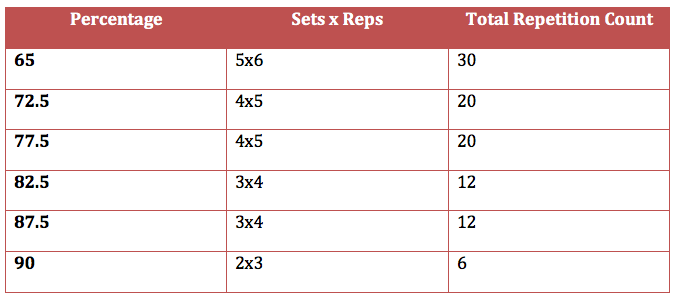
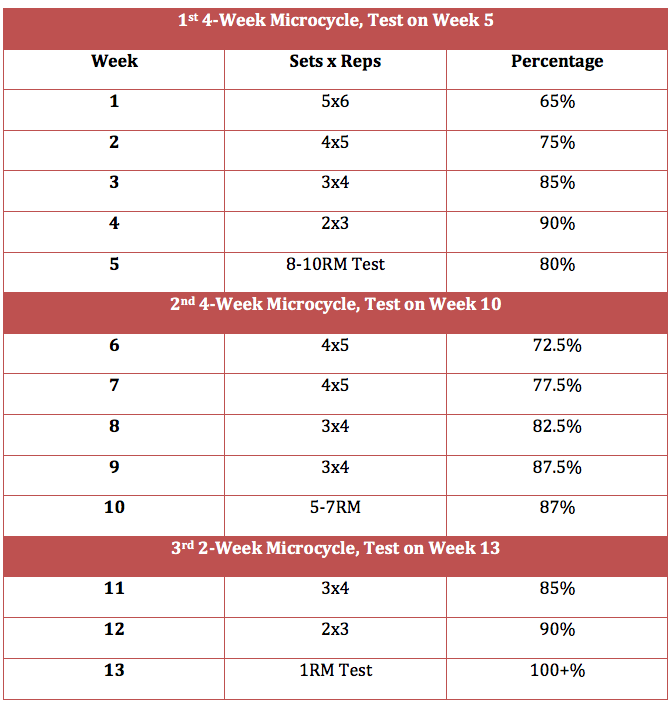
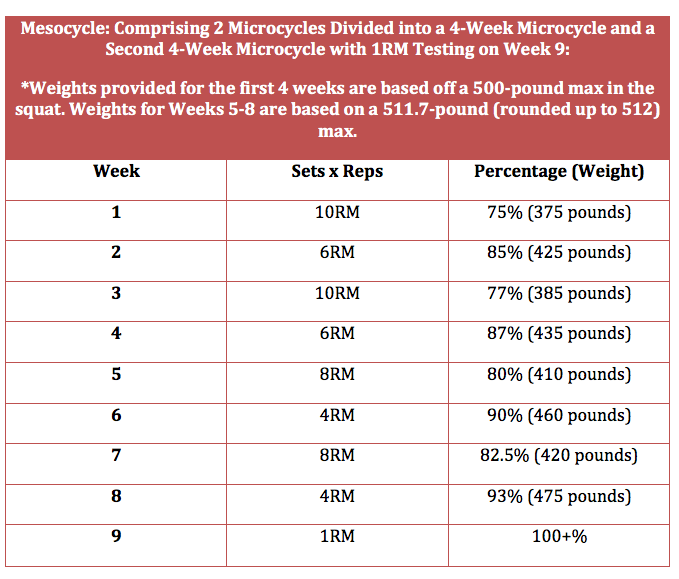
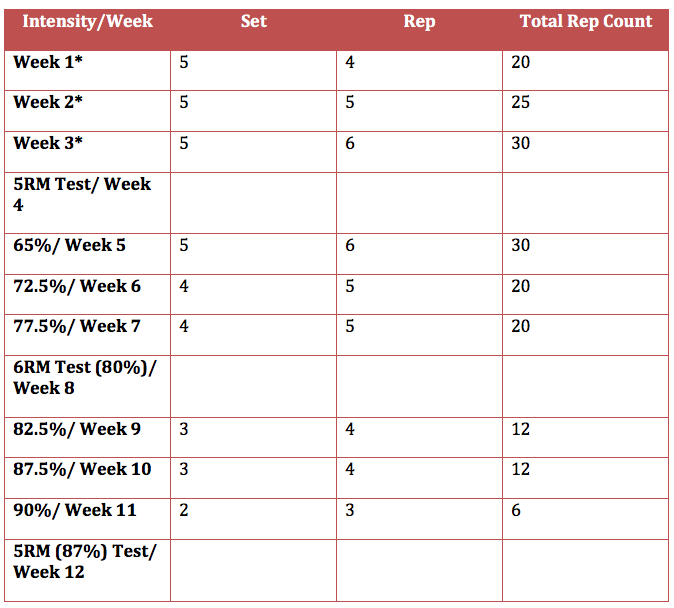

1 Comment